| |
| |
|
|
|
| ASSIER |
| Assier is a large village with a
railway station. The two
monuments in separate places: the parish church and the
Renaissance château,
a short distance apart.
There is plenty of free parking in the village. |
| St Peter's Church |
The church appears to be normally
open. The monument is housed in the north west chape,
left of the main west door. The chapel is rather small
and with difficult lighting.
44°40'31"N 1°52'33"E
|
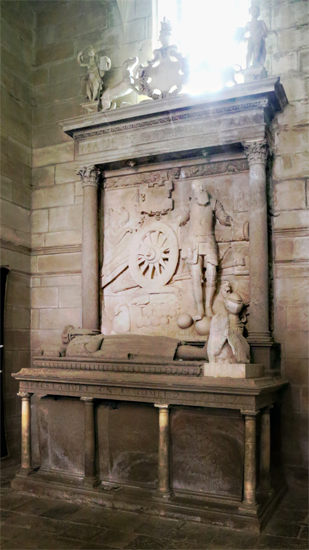 |
 |
Jacques Ricard
(known as )) (1465 - 1546)
Lord of Assier Second
quarter of the 16th century.
|
Soldier and diplomat. He entered royal service under
Louis XI in 1480 and appointed Master and Captain
General of the Artillery in 1512 under Louis XII. He
took part in the Italian Wars and was largely responsible for
the French victory at Marigan under King François
I in 1515. In 1520 he organized the
Field of the Cloth of Gold, the major meeting
between the French and English Kings (Henry VIII)
However in 1525 the French
forces were heavily defeated at the Battle of Pavia
where Galiot, the King
and many leaders were captured.
After his release he negotiated release of the King and
in 1526 was given the title (among many other) of
Grand Ecuyer of France, ranking him among the
senior royal officers. In 1546 he became
Lieutenant-General of Guyene but died later that year.
He was responsible for building the church beginning in
1540. |
| Château
d'Assier |
The Château
of Assier was built by Galiot de
Genouillac between 1518 and 1534. It was partly
demolished in 1768 and the building materials used
elsewhere. However much remains today, including
displaces of many military friezes depicting the
campaigns of Galiot and other stone work. It was
eventually bought by the state and now may be visited in
the summer months at €4 per person.
44°40'27"N 1°52'4"E |

|
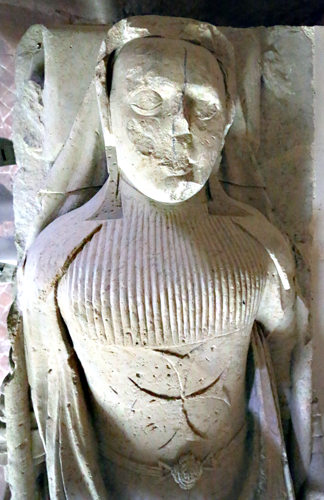 |
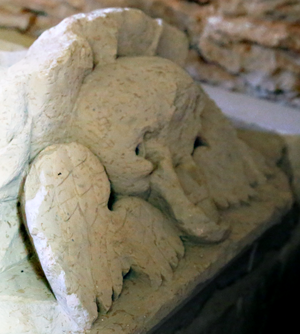
Anne de
Grenouillac (1558-1618)
(Galiote de Ste Anne de Gourdon-Genouillac-Vaillac) Grand Prioress of the Hospital of
Beaulieu, where the tomb was originally situated. Limestone. XV -
early XVII centuries.
Note above the winged skull on which her feet rest. |
 |
|
|
Cahors - Cathedral of St Étienne |
There is parking in both street and
car parks near the cathedral; as far as I could tell
this
is all pay parking.
The cathedral is open and free to enter. Photography is
allowed but flash is not permitted
44º26'50"N
1º26'32"E |
 |
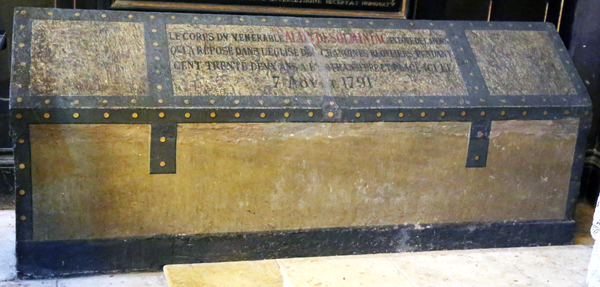 |
Above:
Raymond de Cornil (1293) Bishop of Cahors
(1280-1293)
Limestone. 13th-14th centuries. The feet apper to
rest on a lion and are supported by an angel(s)
Right: Alain de Solmaniac (1659)
Bishop of Cahors (1637-1659)
The list gives this as a gisant; however it is
a tomb chest. The date painted on the lid is
1791. |
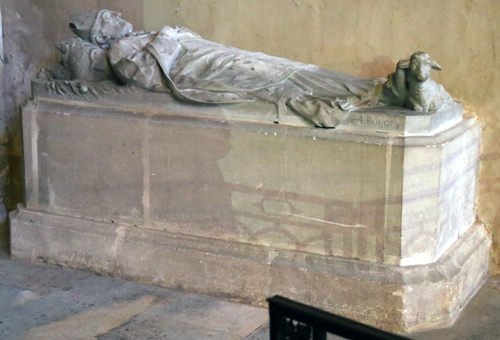 |
 |
Pierre Alfred Grimardias
(1896) Bishop of Cahors 1869-1896
Limestone effigy on plain tomb chest. By A Rougé
1896, signed |
|
|
Castelnau-Montratier - Hôtel
deVille |
The effigy is now in the
Hôtel deVille (town hall). There is plenty of
free parking. The Hôtel
deVille was closed when we arrived but the effigy is on
display in the window and I was able to photograph
it, although it would have produced a better result from
inside the building.
44°16'5"N 1°21'2"E |
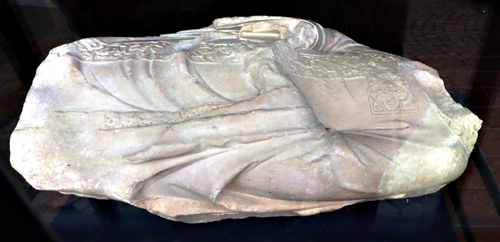 |
Cardinal Bertrand de
Pouget (1352) From a monument in the chapel of
the Poor Clares of Pouget, which was destroyed during
the Revolution. This fragment of the effigy was
discovered by a farmer when ploughing in 1977 and
brought to the Hôtel de Ville,
where it is now on display. XIV century
Cardinal de Pouget was born in the town and became
nuncio to the Avignon popes. He died in Villeneuve-lès-Avignon,
the resort of French cardinals during the Avignon
Papacy. He was responsible for the burning of Dante's
De Monarchia, which argued the separate
authorities of church and state, particularly in
reference to that of Pope and Holy Roman Emperor.
|
|
|
Espagnac-Sainte-Eulalie - St Augustine |
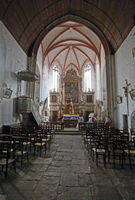 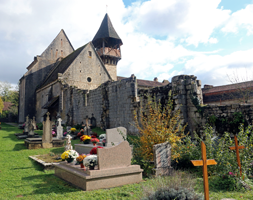 This is a joint commune of two
separate villages. The church is actually in Espagnac,
although the entrance to this village shows the joint
name. The only approach is from the D41
and on the approach road you will shortly see a sign
stating that no vehicles are
allowed into to village. However there is a free -
although small - car park near this sign and to your
left. The car park requires a difficult hair pin turn
to enter (and exit as there are no through roads) from the approach road; I would
suggest you drive a little further and turn around in a
suitable turning space which you will find quickly on your
left. It is a very short walk to the church. This is a joint commune of two
separate villages. The church is actually in Espagnac,
although the entrance to this village shows the joint
name. The only approach is from the D41
and on the approach road you will shortly see a sign
stating that no vehicles are
allowed into to village. However there is a free -
although small - car park near this sign and to your
left. The car park requires a difficult hair pin turn
to enter (and exit as there are no through roads) from the approach road; I would
suggest you drive a little further and turn around in a
suitable turning space which you will find quickly on your
left. It is a very short walk to the church.
The church is locked although, on this occasion, we were fortunate
in obtaining the key from the marie. However to
avoid disappointment after quite a long journey it is
better to follow the instructions on the church gate
'October-April for up to six people, contact:
Christian Thiry 0033 [0]5 81 48 06 57
During the summer there are guided tours twice
daily, 10.30am -12.30pm and 4pm -
6.00pm. The cost is €2.00. The contact
name and number
is as before.
The Church of St
Augustine is that of the Abbey of Espagnac,
Notre-Dame-de-Val Paradise, sometimes
referred to as a priory. It was a
convent of canonesses regular.
44°35'30"N 1°50'27"E |
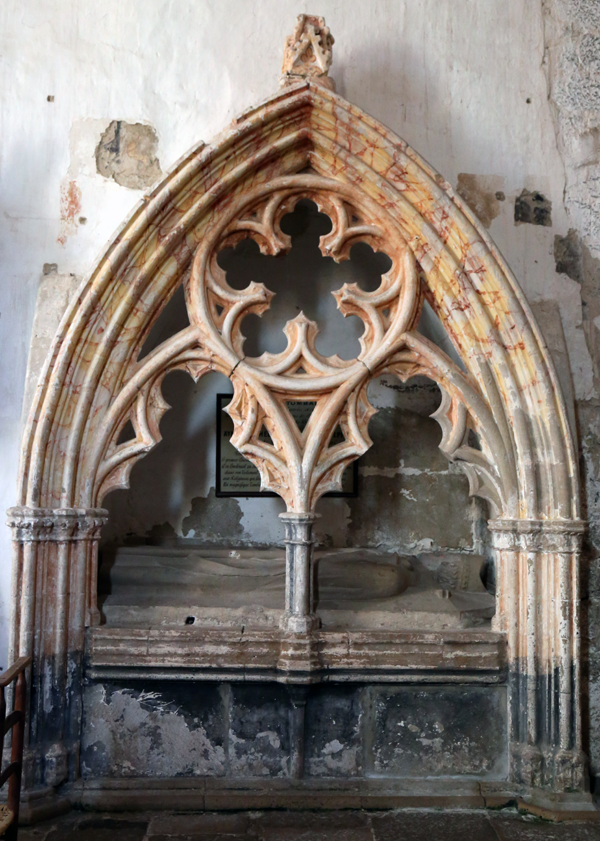
Americ d'Hébrard de
St-Sulpice (1295) Bishop of Coimbra in
Portugal. Refounder of the monastery here. Formerly
identified as François de
Cardaillac de Brengues, Bishop of Cahors (1404). |

|
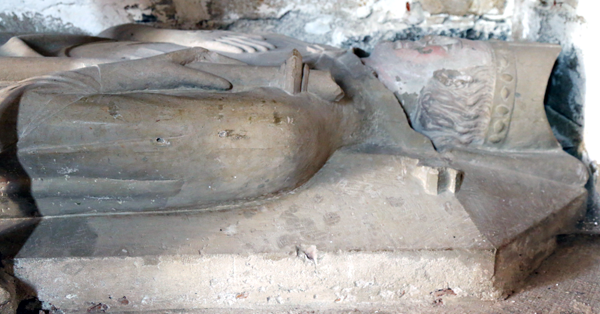 |
 |
 |
Above and left:
Hugues de Cadaillac (1342) Lord of
Brengues
Below: Barnarde (de Trian)
Wife of Hugues above. She was the niece of Pope John
XXII.
These monuments are situated on either side of the
chancel. Excavation is in progress (Nov. 2021) exposing
the base of the tomb chest, the chancel floor having
been raised at some point. As may be seen in the
photographs the excavation is roped off and uncertain
looking so I was unable to get near to the monuments to
take a photograph from another angle.
The monument to the Bishop is in the nave.
|
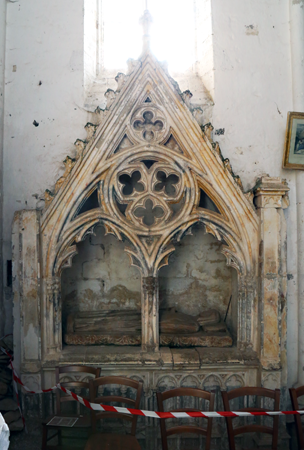
Note the representation of
drapery over the sides of the bier; this is similar to
that carved on the Plantagenet effigies at Fontevraud and
a nearby abbey in Maine-et-Loire. |
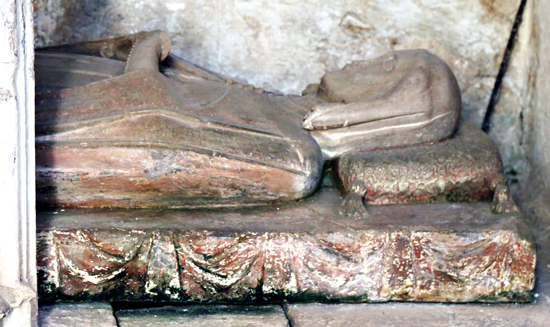
|
 |
|
Meyraguet (Lacave)
Church of Meyraguet |
Meyraguet appears to be a small
village in the commune of Lacave, a short distance from
Lacave itself. The church is small and there is parking
outside. However the well signposted church was
surprisingly locked but there was a notice on the door
requesting visitors to contact the marie to visit;
the telephone number was given. Meyraguet is not
indicated on my map so head for Lacave and follow the
signposts, which are clear.
Knight, stone, XVI century
|
|
| |
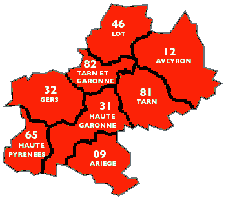 |
TARN-ET-GARONNE |
 |
Tarn-et-Garonne was originally part of the provinces of
Quercy and Languedoc. It was created by Napoleon in 1806
with territories taken from Lot, Haute-Garonne, Gers,
and Aveyron. |
COMMUNES
Montpezat-de-Quercy |
|
| |
 |
Montpezat-de-Quercy
Collégiale St-Martin |
 |
You can park
free in the town square from where it is a short walk to
the church; however this means negotiating a number of
steps and there is no handrail. There appears to be a
car park outside the church but we had already visited
and did not discover how to drive there.
44°14'11"N 1°28'50"E |
 |
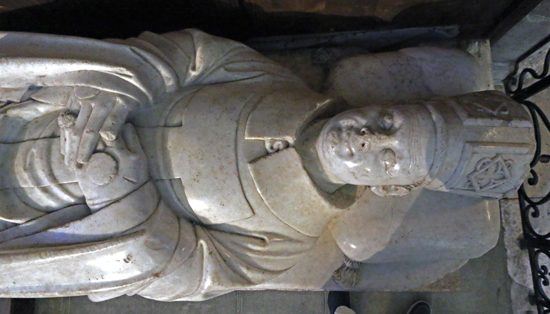 |
 |
 |
Bishop Jean des Près
(1353)
Bishop of Castres
and nephew of the Cardinal. Stone. |
Cardinal Pierre des Près
(1361)
He was the
founder of the Collegiate Church. White marble. |
|
| |
| |
| <Top
of Page> <Home
- Index - Page> |
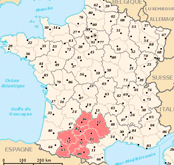








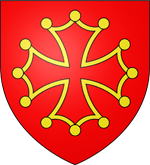













 This is a joint commune of two
separate villages. The church is actually in Espagnac,
although the entrance to this village shows the joint
name. The only approach is from the D41
and on the approach road you will shortly see a sign
stating that no vehicles are
allowed into to village. However there is a free -
although small - car park near this sign and to your
left. The car park requires a difficult hair pin turn
to enter (and exit as there are no through roads) from the approach road; I would
suggest you drive a little further and turn around in a
suitable turning space which you will find quickly on your
left. It is a very short walk to the church.
This is a joint commune of two
separate villages. The church is actually in Espagnac,
although the entrance to this village shows the joint
name. The only approach is from the D41
and on the approach road you will shortly see a sign
stating that no vehicles are
allowed into to village. However there is a free -
although small - car park near this sign and to your
left. The car park requires a difficult hair pin turn
to enter (and exit as there are no through roads) from the approach road; I would
suggest you drive a little further and turn around in a
suitable turning space which you will find quickly on your
left. It is a very short walk to the church.












